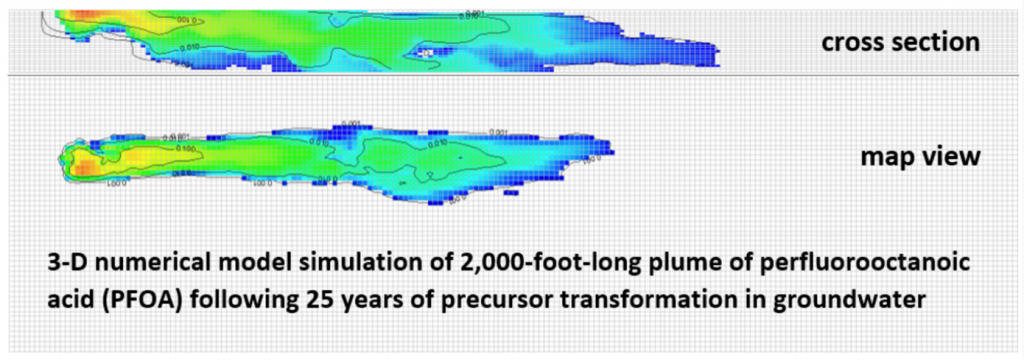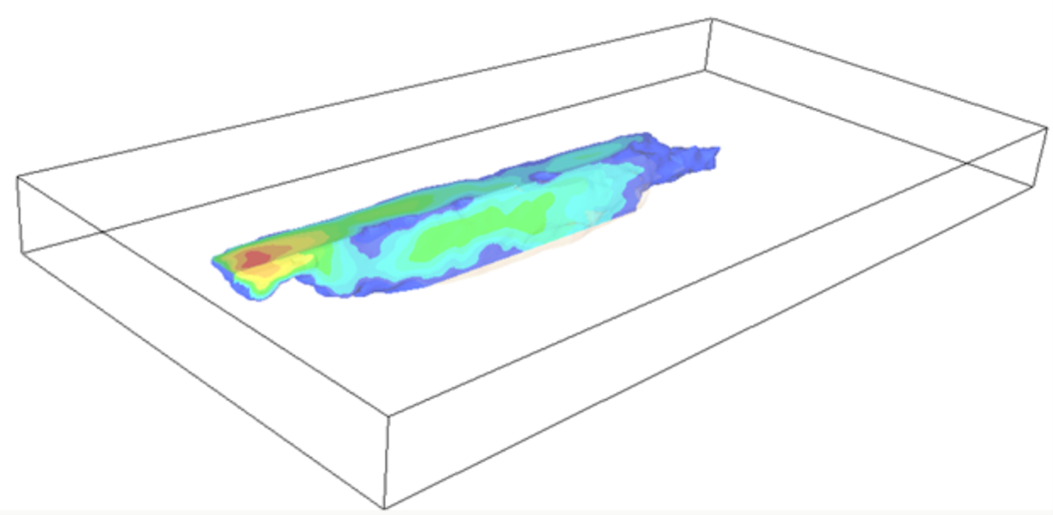PFAS in the Environment Part 4: Anchor QEA’s Fate and Transport Groundwater Modeling
January 25, 2022 – Mike Gefell, Principal Scientist
Per- and polyfluoroalkyl substances (PFAS) are a complex family of synthetic chemicals found in groundwater, surface water, sediments, the atmosphere, and aquatic and terrestrial organisms—including people. Comprised of thousands of compounds with complex properties, PFAS sources with elevated concentrations typically occur near airports, military bases, landfills, wastewater treatment plants, metal-plating facilities, and refineries.
PFAS regulatory criteria for drinking water and groundwater are evolving and becoming more stringent, and PFAS fate and transport in groundwater is an especially complex and potentially daunting problem. Groundwater professionals need tools to solve and evaluate technical issues related to PFAS fate and transport, including the potential impact of PFAS precursors and their transformations in groundwater.

PFAS in groundwater represents a significant and widespread water quality challenge issue.
The Significance of PFAS Precursor Transformation in Groundwater
PFAS regulation and remediation are complicated by the fact that once released into the environment, many PFAS—known as precursors—can transform into other substances, including perfluoroalkyl acids (PFAAs) that are more mobile and potentially more toxic terminal end products. Therefore, it is crucial to better understand precursors and their transformation to PFAAs, including relatively common groundwater contaminants like perfluorooctanoic acid (PFOA)—especially when considering the significant complexity of the chemical properties, fate, and transport of precursors and PFAAs in groundwater.
A Fate and Transport Model with Precursor Transformation and Realistic Complexity
To bridge the gap between conceptual evaluations and remedial decision-making for sites with PFAS in groundwater, Anchor QEA developed a 3-D groundwater fate and transport model with precursor transformation and realistic aquifer complexity. This model allows groundwater professionals to analyze the potential long-term impact of precursors as sources to PFAA groundwater plumes. It also provides insights regarding PFAS fate and transport, including the potential impact of precursor transformation, and informs remedial decision-making by illustrating the site conditions under which precursors may significantly alter the fate and longevity of PFAAs, including PFOA.
Anchor QEA’s recent publication of PFAS fate and transport in Groundwater journal was the first with precursor transformation and realistic aquifer complexity. Access the publication here.

Understanding and quantifying PFAS fate and transport in groundwater requires technical expertise in PFAS chemistry, geology, geochemistry, groundwater hydraulics, and numerical modeling.
Simulating the movement of the groundwater and the chemicals of interest, the model was used to produce two nearly identical PFOA plumes from two entirely different hypothetical sources—one with only a precursor, and the other one with only PFOA. These scenarios bracket the potential range of source terms. Both simulations predicted PFOA plumes lasting decades, but the precursor-sourced PFOA plume lasted for over 75 years, whereas the plume without precursors had almost completely attenuated.
These results show that when a precursor is present, it can impact PFAA plume concentrations and extend PFAA plume durations by decades. With realistic aquifer complexity, the model shows in detail how PFAS and precursors migrate in groundwater, the distribution of chemical concentrations in groundwater, and the fate of precursors and PFOA following source remediation.

3-D numerical modeling results show that by adjusting the mass loading rate, source zones with or without a precursor can produce similar PFAA plumes. However, if a precursor is present, it can impact PFAA plume concentrations and extend PFAA plume durations by decades.
How Long Will PFAS Remain in an Aquifer?
With this and similar models, Anchor QEA’s team tests conditions under which a precursor could significantly impact plume longevity, including the influence of remedial options: monitored natural attenuation, source removal, source-area capping, in situ solidification, barrier walls, pump and treat, colloidal activated carbon injection, and permeable reactive barriers containing activated carbon. Simulating remedial options with and without potential precursor transformations is key to successfully managing these chemicals in the environment. Additional research regarding in situ precursor transformation rates—and improvements in source area characterization—will further advance the predictive value of modeling.
Insights gained from this model will help project teams develop cost-effective plume management programs to address PFAS contamination. At Anchor QEA, we are continuing to develop a suite of mechanistic models with PFAA precursor transformation, including the groundwater fate and transport model just described, a bioaccumulation model, and a sediment and surface water model, to better understand the influence of precursor transformations across a range of environmental media.
Author
Related Insights
Addressing PFAS in the Environment Part 2: Anchor QEA’s Bioaccumulation Model
April 29, 2021 – David Glaser and Dan Opdyke
Continue Reading »Addressing PFAS in the Environment Part 3: Anchor QEA’s Sediment and Surface Water Model
August 26, 2021 – Elizabeth Lamoureux, Senior Managing Scientist, and David Glaser, PhD, Principal
Continue Reading »

 Mike Gefell
Mike Gefell